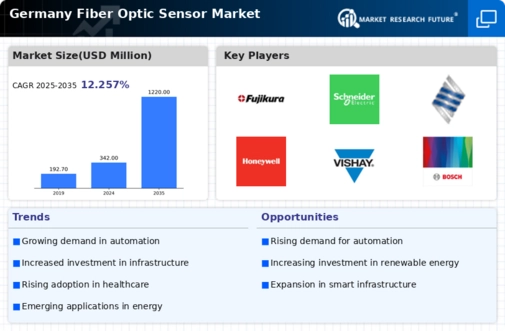The Germany Fiber Optic Sensor Market is characterized by a rapidly evolving landscape driven by advancements in technology and a growing demand across various sectors such as telecommunications, manufacturing, and environmental monitoring. As industries increasingly adopt fiber optic technologies for their reliability, sensitivity, and ability to operate in harsh environments, the competitive environment has intensified. Key players are working on innovative solutions to enhance sensor performance, improve integration capabilities, and address specific industry needs.
Moreover, the market is influenced by emerging trends such as the Internet of Things (IoT) and smart infrastructure development, prompting companies to invest in research and development to stay ahead of the competition and cater to the growing requirements of customers. Fujikura has established a strong foothold within the Germany Fiber Optic Sensor Market thanks to its commitment to innovation and quality. The company’s advanced sensor technologies are well-regarded for their precision and reliability, making them ideal for critical applications across varying industries.
Strengthened by a robust distribution network, Fujikura effectively reaches out to its customer base within Germany, ensuring swift availability and support. The company’s history of investing in state-of-the-art manufacturing processes and continuous improvements facilitates its capacity to deliver cutting-edge products tailored to meet the specific needs of the German market.
Furthermore, Fujikura’s strategic collaborations with local firms and research institutions enhance its market penetration and yield beneficial partnerships that uplift its recognition and credibility in the region.Schneider Electric has made significant inroads into the Germany Fiber Optic Sensor Market, offering a comprehensive portfolio of products and services that cater to diverse applications. The company is known for its innovative solutions that seamlessly integrate energy management and automation, making use of fiber optic sensing technology for enhanced operational efficiency.
Schneider Electric's strength lies not only in its vast range of key products, including smart sensors and monitoring systems but also in its commitment to sustainability and alignment with the growing trends of digital transformation. The company has expanded its market presence through strategic mergers and acquisitions, allowing it to consolidate resources and expertise within Germany. This proactive growth approach has bolstered its position in the market, ensuring that Schneider Electric remains a key player with significant influence in driving technological advancements and providing reliable solutions in the fiber optic sensor domain.



















